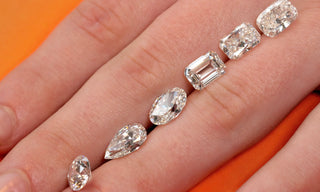One of the biggest myths floating around about lab grown diamonds is that they’ll eventually turn yellow. The idea has been repeated so many times that people think it must be true. But is there any science behind it, or is this just another story pushed by the natural diamond industry to keep lab diamonds in the shadows?
Where the Rumor Started
The claim that lab diamonds turn yellow over time didn’t come out of thin air. It’s been whispered around the industry for years, usually by those with a lot to lose if consumers shift to lab grown. Natural diamonds have been marketed as rare, eternal, and superior for decades. The idea that lab diamonds might discolor was a convenient way to create doubt.
The Science of Diamond Color
Here’s the truth: both lab grown and natural diamonds are made of pure carbon, crystallized into the same atomic structure. Neither changes color with age. If a diamond looks yellow, it’s because of its color grade at the time it was cut, or the way light reflects off it. The color is locked into the crystal structure and won’t magically appear years later.
De Beers and the Marketing Push
It’s worth looking at who benefits from the rumor. De Beers, one of the biggest names in natural diamonds, has spent decades shaping how people think about these stones. From the famous “A diamond is forever” campaign to their more recent Lightbox venture in lab diamonds, they’ve had a huge influence on consumer perception. Lightbox offered lab diamonds at low, flat prices but never treated them as fine jewelry, almost like they wanted to keep lab grown stones in a separate, “less serious” category.
When De Beers shut down Lightbox’s expansion and doubled down on natural stones, many in the industry saw it as a sign. They couldn’t prove lab diamonds were any less durable or less brilliant, so the next best strategy was to push stories that made people doubt them.
Do Lab Diamonds Actually Change Over Time?
No. Lab grown diamonds don’t fade, they don’t cloud, and they don’t suddenly shift to yellow. They hold their color and brilliance just like mined diamonds do. If you’re looking at a lab diamond that appears warm in tone, it’s because of its original color grade, not because it “changed” later.
Why the Myth Sticks Around
The myth survives because it plays on fear. Engagement rings are emotional purchases. No one wants to spend money on a symbol of love only to be told it might lose its sparkle. By planting doubt, the natural diamond industry keeps lab grown diamonds from completely taking over the mainstream market.
Final Thoughts
So, do lab diamonds turn yellow over time? No. That rumor has no scientific basis. It’s more about protecting a market than telling the truth. Lab grown diamonds are as stable, as brilliant, and as long-lasting as mined ones. What changes isn’t the stone, it’s the story people are told about it.
If you’re ready to cut through the myths and focus on what truly matters, brilliance, beauty, and craftsmanship, explore Azzallure’s lab grown diamond collection. From timeless classics to bold statement rings over 10 carats, each piece is designed to last a lifetime without the inflated price or the outdated narratives. Discover a diamond that sparkles with truth as much as it does with light.


